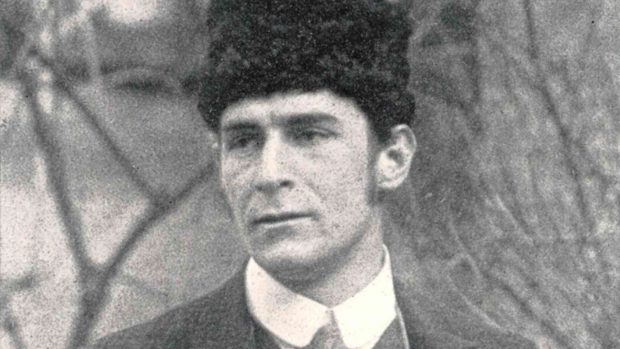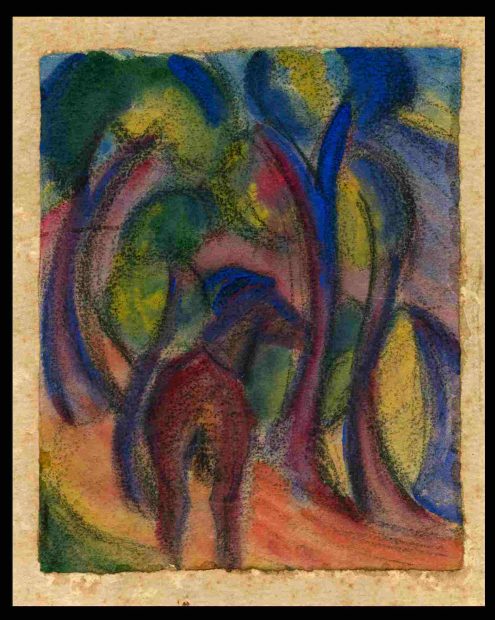This fascinating true story, which OKDIARIO will publish in five parts, details the possible discovery of a painting by Franz Marc, German artist of the early twentieth century and founder of the expressionist movement called The Blue Rider, to which Kandinsky and Paul Klee also belonged. The painting appeared in a chest of drawers in the former home of the artist and photographer Guillem Bestard in Pollença, in the north of Mallorca. This work by Franz Marc was acquired from Bestard’s granddaughter by another artist and researcher who rented the house. Over the years, he initiated an investigation suspecting that, although he was unsigned, he could be a Franz Marc, since all the characteristics indicated it.
The history What I am going to summarize here is fascinating and it must serve, among other things, to value a cultured early 20th century Mallorca open to European cultural movementsparticularly cosmopolitan, so different from the one that has sometimes been imposed on us through the little black legend that began perhaps in the famous recriminatory writing of George Sand.
Because the characters that star in it are far from that crude cliché that the tourist explosion has brought us. Surely there was less economic dynamism, it may even be that poverty had more incidence at the beginning of the 20th century, but what I have no doubt is that the culture enjoyed excellent health, at least among a good part of the relatively well-off society. , to a much greater extent than in the decades that have followed.
The first protagonist of this story is from Pollença and his name is Guillem Bestard i Canaves. Born in 1881, very early, due to relations with visiting foreigners – his family ran an inn where many travelers stopped -, specifically Due to his friendship with a German painter in this case, he became acquainted with photography at a very young age., and became completely obsessed with this technique, which he would not abandon in his entire life. The first camera was given to him precisely by this artist, who, as I have mentioned, had made it known to him, when he returned the following year with a device for himself. Guillem was only 18 years old.
This present would mark his life, since he immediately began to make portraits and landscape shots. The family, seeing the boy’s interest in this new technique, acquired the house next to the inn to open a laboratory and a gallery there; this space would soon become the Pollença athenaeum, artistic and intellectual center in which English was spoken, poetry was read, piano and violin concerts were held…
William Bestard would associate with artists and intellectuals throughout his life, and not only on the island, in his native Mallorca, but also during his stays in Barcelona, Parisand his long settlement with his second wife, exiled after the civil war, in England. In Paris he won, in 1910 (his first stay in the capital of France is very probably dated to that date), the first prize for artistic photography (gold medal), with a photograph of an old woman dressed as a peasant, setting laurel leaves and sitting on the steps that go up to Calvary in Pollença. He had made the emulsion for the paper in the photograph himself, mixing gum arabic with metallic salts called dichromates, in a technique known as noble impressions. The jury predicted: «Special distinction to the most artistic photographic procedure known».
In 1912 he won three more prizes, in Paris, Brussels and Barcelona. painter’s friend Antoni Gelabert, of the artists who began to arrive in Pollença as Titto Cittadini, Anglada, Castellanos, Llorenç Ribes, Joaquim Mir, Santiago Rossinyol, William Degouve da Nucques, Sorolla (some of them even resided in his house); of the patron adam dhielwhich built the legendary Formentor hotel.
Guillem Bestard became a rallying point for those illustrious visitors, who in turn generously returned his attentions by introducing him to other international artists in at least the Mallorcan photographer’s stay in Paris in 1928 and others. Hence, he established a relationship with many of them, especially German-speaking expressionists like Wilhelm Lehmbruck and Jean Egger. That is why there is an easy explanation for the fact that the collection of works that Guillem Bestard built up over the years It was made up of a multitude of works by well-known artists in Pollença as well as in Paris or Barcelona. Firms such as Joaquim Mir, the aforementioned Lehmbruck, Eugene Delatres, Emile Leroy, etc. they were present. And also, and here is what interests and matters to us, there were several unsigned drawingssome clearly attributable to Mir, others to various expressionists, and especially the one that has been the subject of the investigation that I collect in this report, a drawing that has all the appearances of being able to be attributed to Franz Marc.

Here we come to the second protagonist of this story, the German artist Franz Marc, one of the main representatives of German expressionism of the 20th century. Born in Munich in 1880, he caused a sensation very soon with the portrait of animals -never better said than in his case the portrait- using primary colors initially inspired by the palette of Robert Delunay: Blue used to represent masculine austerity and spirituality, yellow for feminine joy, and red for violence. Those colors are always present in his works, together with a strange natural force that runs through all the works and that arises from the emotion before what life in its purest form poses.
Of course, this was in its beginnings, given that it later evolved from impressionism to symbolism (so loved by the French poetry of its time, by the way), passing through cubism and futurism, ending with an approach close to abstraction (an abstraction of a figurative nature, if that is how it can be referred to) without openly leading to it. He didn’t give more time, because when World War I broke out he enlisted as a volunteer and perished at the Battle of Verdun in 1916 when a burst of shrapnel hit him in the head, at only 36 years old. He had founded, together with other artists, the very important movement Der Blaue Reiter (The Blue Rider), which would bring together for history the most relevant European expressionist creators, who are, in addition to himself, Vasili Kandinsky, August Macke and Paul Klee, among many others.
Frank Marc he had discovered impressionism on a trip to Paris in 1903, and since then he has not stopped visiting the capital of France, then a veritable hive of art, spending long periods of time there. And specifically, in the year 1912, when Guillem Bestard won his first prize for photography, Franz Marc was also in Parisin a long stay financed by the collector Bernhard Kohler. Although, to tell the truth, there is no certainty that they would meet and treat each other, despite the fact that the probability is high given the artistic fields in which the two moved. In any case, Franz Marc worked in Paris for many periods of his short life and it is not surprising that his works remained there after his disappearance in 1916.

Tomeu Lamo
The The third character in this story is Bartomeu Payeras i Cifre, known in the art world as Tomeu Lamo. Born in Artà in 1948, he is, in addition to an artist with a broad multidisciplinary career spanning more than 50 years, with a multitude of exhibitions and interventions in various spaces and a catalog of more than 3,500 works, a biologist specializing in microbiology, with an equally long career both in the field of research and teaching.
But, above all, as far as we are concerned here, Tomeu Lamo is also known for the application of the scientific method to determine the authorship of certain works of art, as is the case with The intrauterine birth of Salvador Dalí, which after 27 years of analysis has managed to prove that it belongs to Dalí, and is considered the first surrealist work by the artist. In this sense, has discovered and made public the so-called Dalí Code, a numerological code that the artist used to encrypt his secrets inside his paintings. He has also released the interpretation of Dali’s soft clocks and his famous painting The Persistence of Memory. All this has been published in various books, such as The intrauterine birth of the divine Dalí, Dalí, what time is it? Y Dalí-Llull and his theaterin which the relationship between Salvador Dali and Ramon Llull to which we owe the inspiration and interpretation of its Theatre-Museum.
The application of methods of pigment analysis, contextualization and dating, submission to probabilistic mathematical calculation, introducing various compatibility variables, have allowed Tomeu Lamo, prior to the case of the work of Franz Marc that we are dealing with here, the determination of authorship eight works corresponding to the Austrian expressionist Hans Egger, Vicente López, Joaquim Mir, Anglada Camarasa, Isidre Nonelletc.
But where he has made more analytical effort and where he has found a more extravagant response from some of the institutions involved has been with the work attributable to Franz Marc entitled Red and blue goat between trees. A work that has appeared in Mallorca.
The incredible discovery of a million-dollar work by Franz Marc in Mallorca

